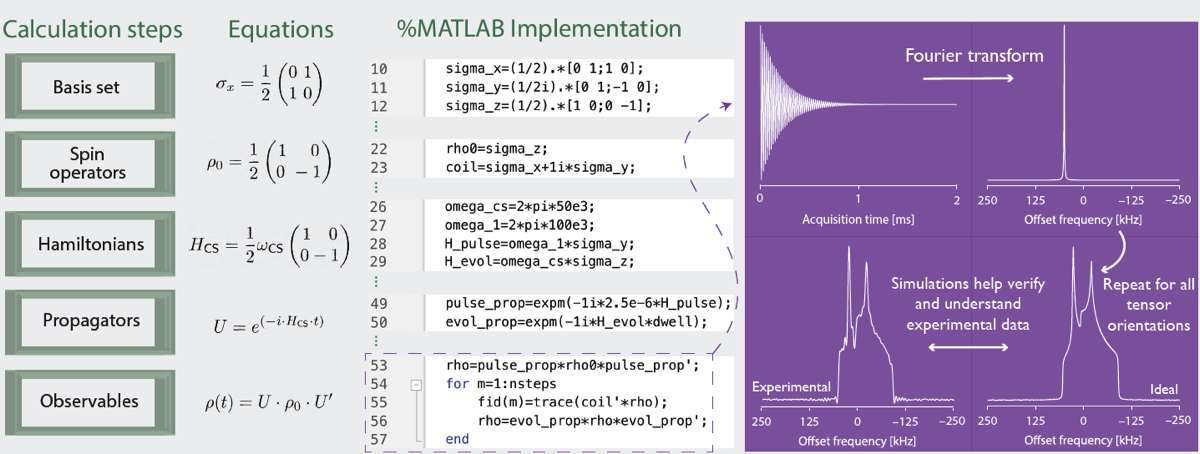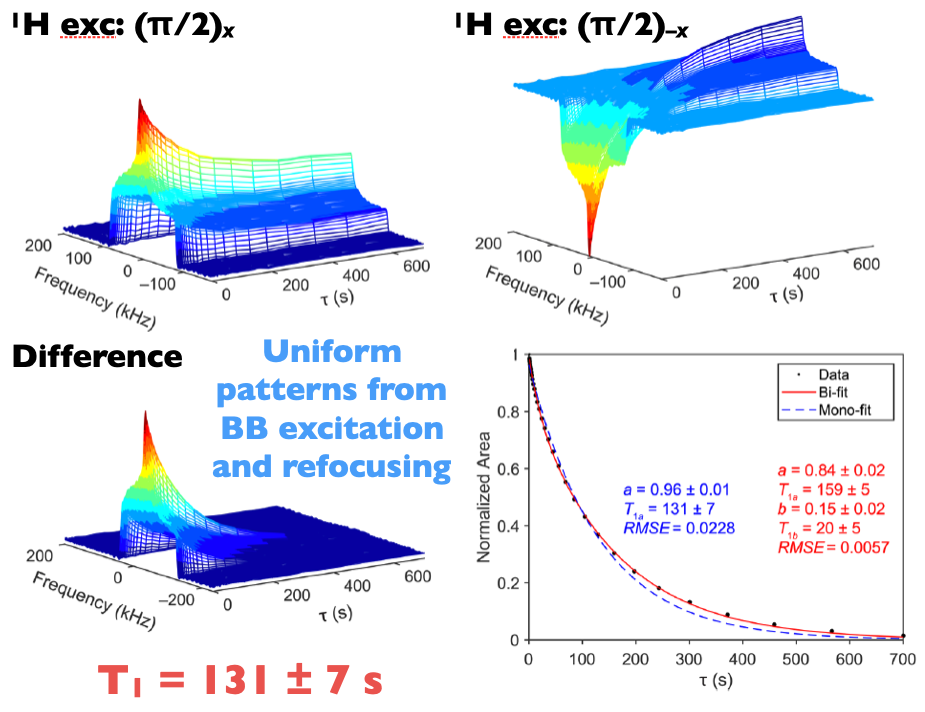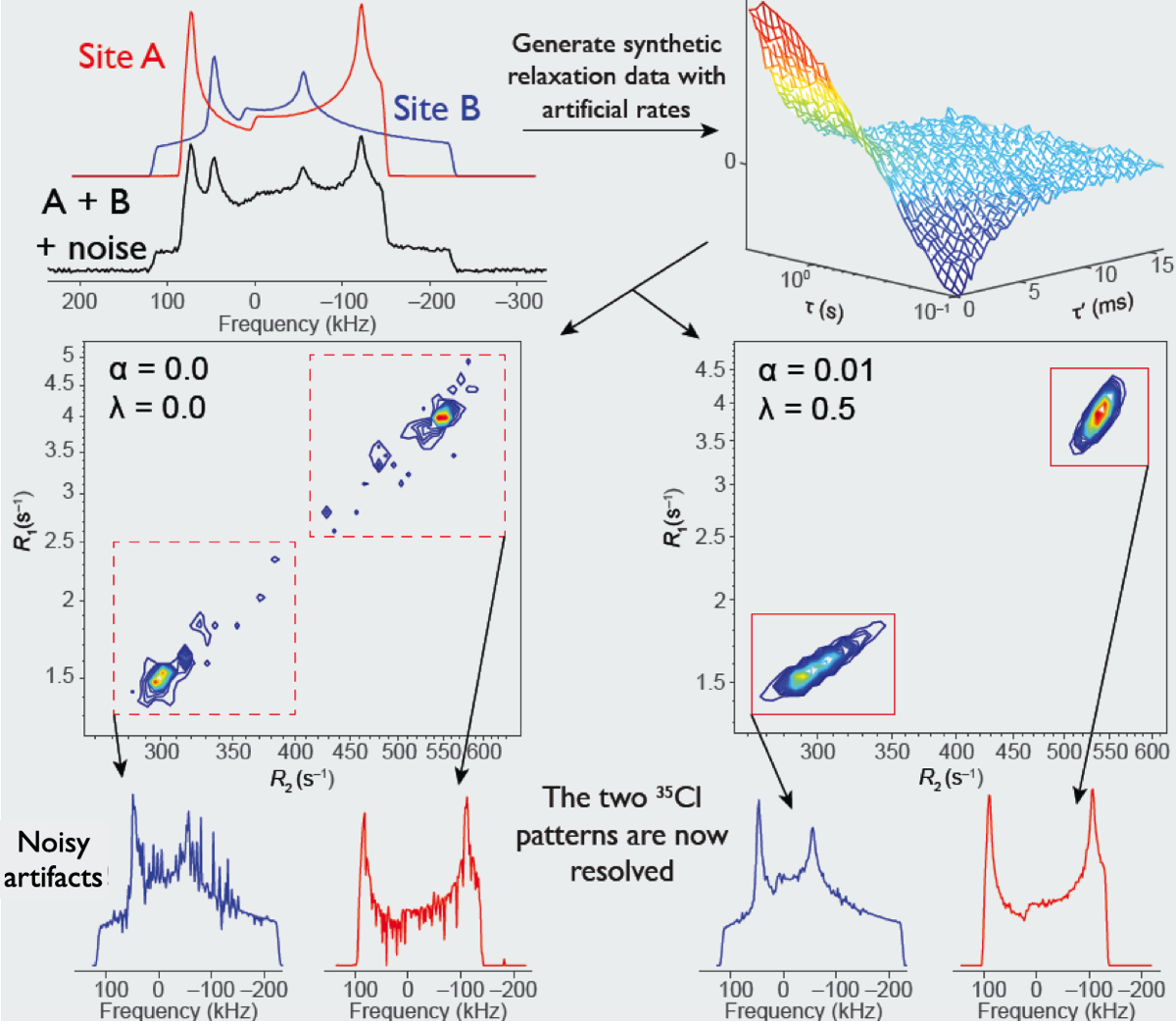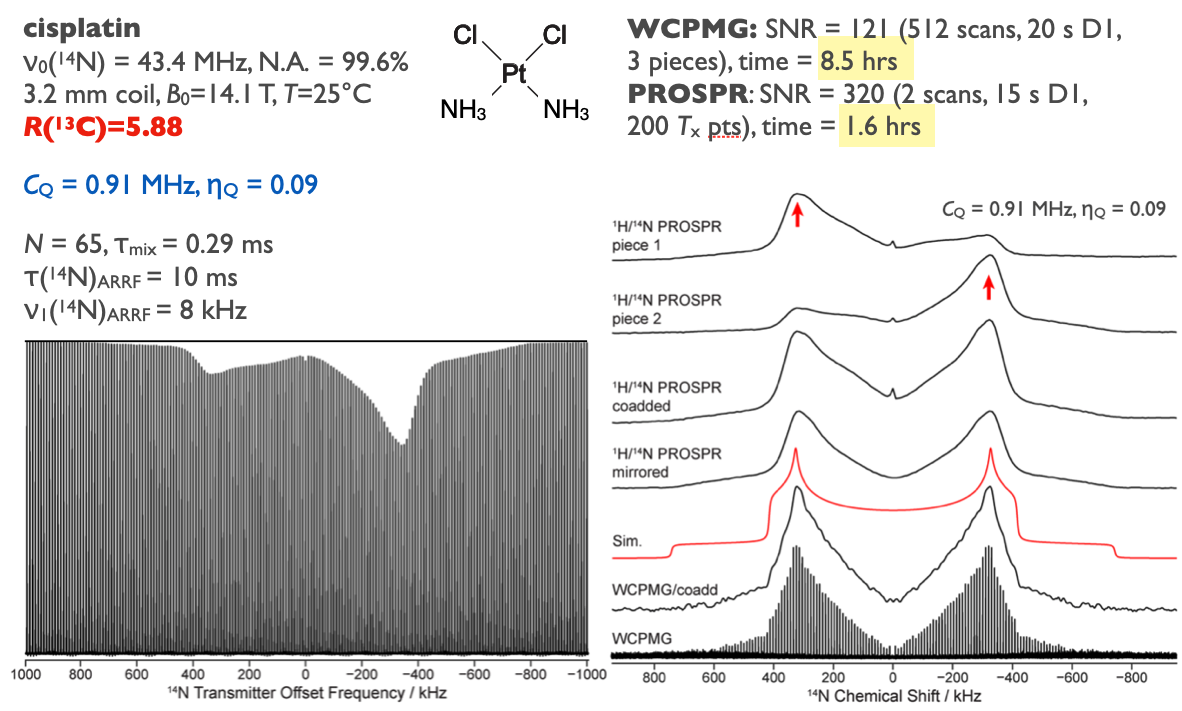Key to obtaining spectra that are of high quality (i.e., high signal, resolution, and uniformity), and suitable for analysis, is the design of new pulses, pulse sequences, and spectral processing methods.
Simulations employing software like MATLAB, SIMPSON, and SPINACH can be used to optimize SSNMR experiments, and probe the underlying spin physics:

Specialized pulse sequences can be designed for the measurement of nuclear relaxation properties in ultra-wideline solid-state NMR spectra, like this example of 1H-119Sn BRAIN-CPT1/WURST CPMG for tetrabutyltinoxide:

Relaxation properties (T1 and T2) can be exploited for the separation of overlapping UW NMR powder patterns. This is accomplished with new 3D relaxation-assisted separation techniques, that use non-negative least square fitting routines, featuring: stabilized inverse Laplace transforms (ILTs) with elastic net (EN) regularization, denoising of relaxation data with principal component analysis (PCA), and more regularization and faster computation with truncated singular-value decomposition (TSVD).

Finally, we are working with collaborators from the Weizmann Institute (Lucio Frydman) to design pulse sequences for the indirect detection of ultra-wideline NMR spectra for stationary (i.e., not magic-angle spinning) samples. Below, the 1H-14N PROSPR spectrum of cisplatin is compared to spectra acquired with WURST-CPMG:

Selected papers on pulse sequence design, spectral processing, and numerical tools
- Altenhof, A. R.; Jaroszewicz, M. J.; Harris, K. J.; Schurko, R. W. Broadband Adiabatic Inversion Experiments for the Measurement of Longitudinal Relaxation Time Constants. J. Chem. Phys. 2021, 154, 034202. https://doi.org/10.1063/5.0039017.
- Jaroszewicz, M. J.; Altenhof, A. R.; Schurko, R. W.; Frydman, L. Sensitivity Enhancement by Progressive Saturation of the Proton Reservoir: A Solid-State NMR Analogue of Chemical Exchange Saturation Transfer. J. Am. Chem. Soc. 2021, 143, 19778–19784. https://doi.org/10.1021/jacs.1c08277.
- Altenhof, A. R.; Wi, S.; Schurko, R. W. Broadband Adiabatic Inversion Cross‐polarization to Integer‐spin Nuclei with Application to Deuterium NMR. Magn. Reson. Chem. 2021, 59, 1009–1023. https://doi.org/10.1002/mrc.5145.
- Hung, I.; Altenhof, A. R.; Schurko, R. W.; Bryce, D. L.; Han, O. H.; Gan, Z. Field‐stepped Ultra‐wideline NMR at up to 36 T: On the Inequivalence between Field and Frequency Stepping. Magn. Reson. Chem. 2021, 59, 951–960. https://doi.org/10.1002/mrc.5128.
- Altenhof, A. R.; Jaroszewicz, M. J.; Lindquist, A. W.; Foster, L. D. D. D.; Veinberg, S. L.; Schurko, R. W. Practical Aspects of Recording Ultra-Wideline NMR Patterns under Magic-Angle Spinning Conditions. J. Phys. Chem. C 2020, 124, 14730–14744. https://doi.org/10.1021/acs.jpcc.0c04510.
- Altenhof, A. R.; Lindquist, A. W.; Foster, L. D. D.; Holmes, S. T.; Schurko, R. W. On the Use of Frequency-Swept Pulses and Pulses Designed with Optimal Control Theory for the Acquisition of Ultra-Wideline NMR Spectra. J. Magn. Reson. 2019, 309, 106612. https://doi.org/10.1016/j.jmr.2019.106612.
- Wi, S.; Schurko, R. W.; Frydman, L. Broadband Adiabatic Inversion Cross-Polarization Phenomena in the NMR of Rotating Solids. Solid State Nucl. Magn. Reson. 2018, 94, 31–53. https://doi.org/10.1016/j.ssnmr.2018.08.003.
- Wi, S.; Schurko, R.; Frydman, L. 1H-2H Cross-Polarization NMR in Fast Spinning Solids by Adiabatic Sweeps. J. Chem. Phys. 2017, 146. https://doi.org/10.1063/1.4976980.
- Wi, S.; Kim, C.; Schurko, R.; Frydman, L. Adiabatic Sweep Cross-Polarization Magic-Angle-Spinning NMR of Half-Integer Quadrupolar Spins. J. Magn. Reson. 2017, 277, 131–142. https://doi.org/10.1016/j.jmr.2017.02.021.
- Jaroszewicz, M. J.; Frydman, L.; Schurko, R. W. Relaxation-Assisted Separation of Overlapping Patterns in Ultra-Wideline NMR Spectra. J. Phys. Chem. A 2017, 121, 51–65. https://doi.org/10.1021/acs.jpca.6b10007.
- Wi, S.; Gan, Z.; Schurko, R.; Frydman, L. Cross-Polarization Phenomena in the NMR of Fast Spinning Solids Subject to Adiabatic Sweeps. J. Chem. Phys. 2015, 142. https://doi.org/10.1063/1.4907206.
- Harris, K. J.; Veinberg, S. L.; Mireault, C. R.; Lupulescu, A.; Frydman, L.; Schurko, R. W. Rapid Acquisition of N-14 Solid-State NMR Spectra with Broadband Cross Polarization. Chem. Eur. J. 2013, 19, 16469–16475. https://doi.org/10.1002/chem.201301862.
- Harris, K. J.; Lupulescu, A.; Lucier, B. E. G.; Frydman, L.; Schurko, R. W. Broadband Adiabatic Inversion Pulses for Cross Polarization in Wideline Solid-State NMR Spectroscopy. J. Magn. Reson. 2012, 224, 38–47. https://doi.org/10.1016/j.jmr.2012.08.015.
- MacGregor, A. W.; O’Dell, L. A.; Schurko, R. W. New Methods for the Acquisition of Ultra-Wideline Solid-State NMR Spectra of Spin-1/2 Nuclides. J. Magn. Reson. 2011, 208, 103–113. https://doi.org/10.1016/j.jmr.2010.10.011.
- O’Dell, L. A.; Harris, K. J.; Schurko, R. W. Optimized Excitation Pulses for the Acquisition of Static NMR Powder Patterns from Half-Integer Quadrupolar Nuclei. J. Magn. Reson. 2010, 203, 156–166. https://doi.org/10.1016/j.jmr.2009.12.016.
- O’Dell, L. A.; Rossini, A. J.; Schurko, R. W. Acquisition of Ultra-Wideline NMR Spectra from Quadrupolar Nuclei by Frequency Stepped WURST-QCPMG. Chem. Phys. Lett. 2009, 468, 330–335. https://doi.org/10.1016/j.cplett.2008.12.044.
- O’Dell, L. A.; Schurko, R. W. Fast and Simple Acquisition of Solid-State N-14 NMR Spectra with Signal Enhancement via Population Transfer. J. Am. Chem. Soc. 2009, 131, 6658–6659.
- O’Dell, L. A.; Schurko, R. W. QCPMG Using Adiabatic Pulses for Faster Acquisition of Ultra-Wideline NMR Spectra. Chem. Phys. Lett. 2008, 464, 97–102. https://doi.org/10.1016/j.cplett.2008.08.095.
